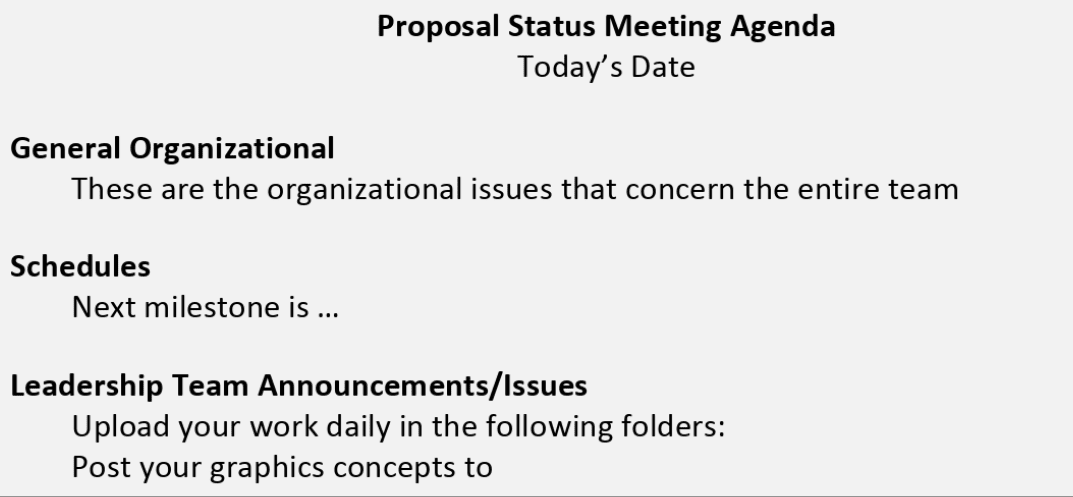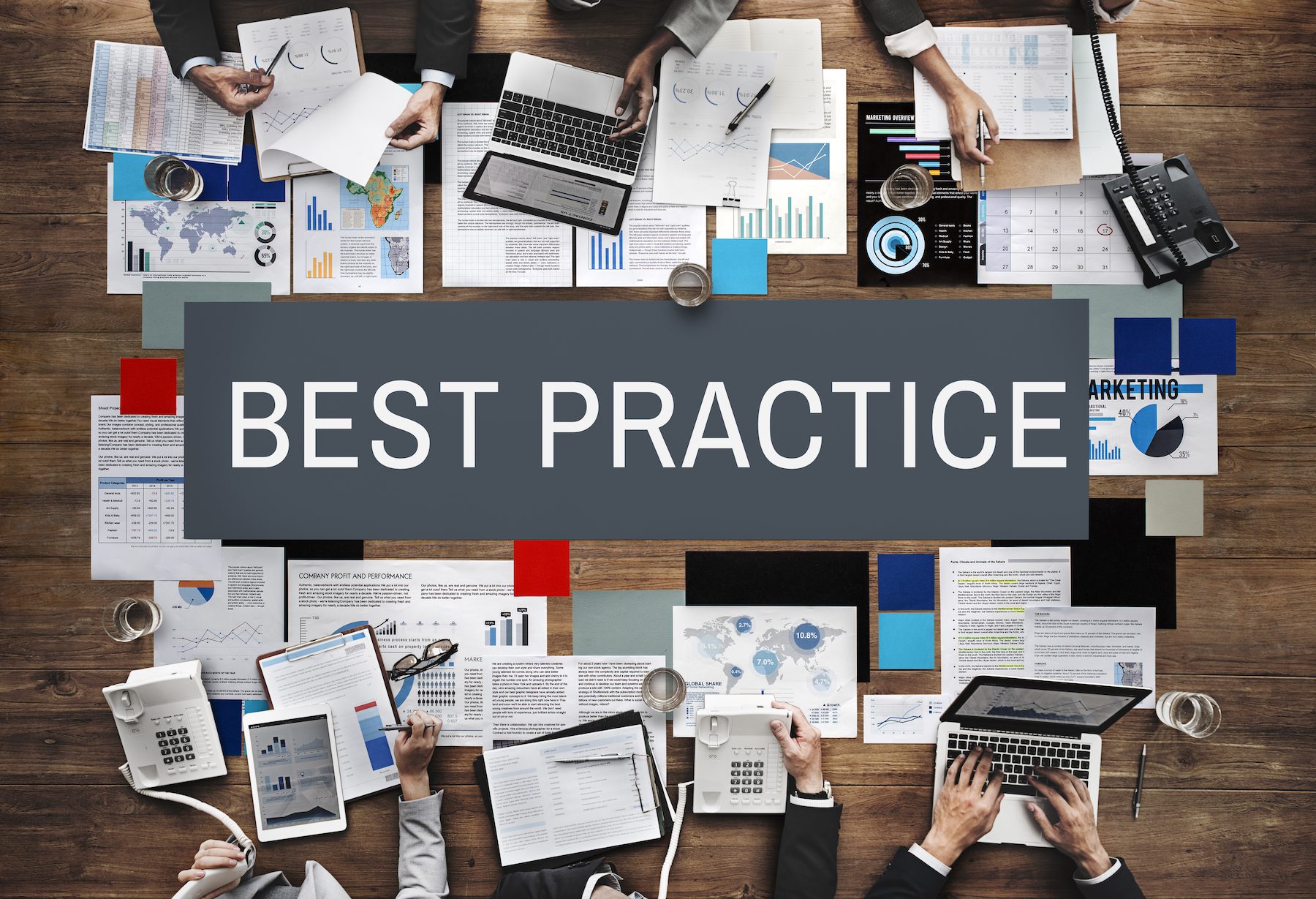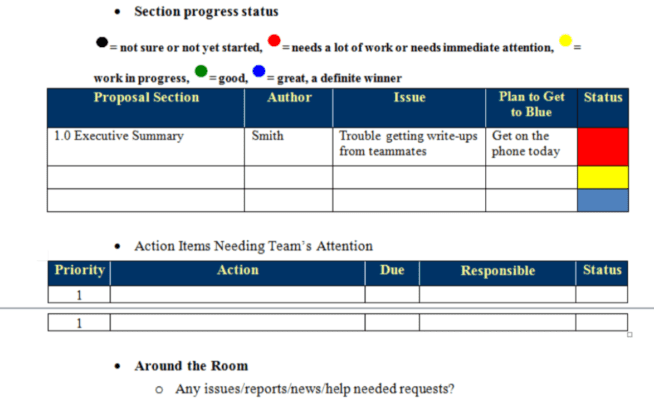Proposal Management Best Practices
We have seen it time and again. You’ve executed an outstanding capture effort. You learned everything the customer wants. You’ve assembled a team of all-star companies who have past performance identical in size, scope, and complexity. Your team knows all of the customers’ hot buttons. You’ve vetted your solution with the customer, and they’re excited to receive your proposal. Now it’s time to hand capture off to your proposal team.
From a capture perspective, this opportunity is a slam dunk, but a subpar proposal can still lose. Even when the customer wants you to win. You can help prevent this by incorporating these proposal management best practices into your proposal development effort.
In addition to gathering lessons learned following each proposal submission and conducting continuous process improvement, this article discusses other best practices you can add to your proposal management process.
Bring Your Proposal Manager in During Capture
Capture and proposal managers should have a very close relationship. Either person operating independently of the other is a mistake, which will reflect in your proposal. Your proposal manager shouldn’t learn about this opportunity once the final RFP has been released. The best time to engage your proposal team is during the draft RFP phase to assist with the final solution development. They can help brainstorm with the subject matter experts and capture team to develop the concept of operations graphic, and how your win themes will show up in the proposal.
Conduct a Comprehensive Kickoff
Proposal and Capture managers can start the proposal off right by conducting a great kickoff meeting. The kickoff is the best opportunity to:
- Get everyone on the same page
- Create momentum
- Announce key milestones, dates, and deadlines
- Get the entire team’s buy-in on the process (including senior management)
- Set the tone and discuss win themes
- Emphasize the importance of each person’s role and assignments throughout the process
Hold Just-In-Time Training
The concept of just-in-time training is to give your team short training sessions right when you get to that part of the process. For example, right after the kickoff, you can provide training on how to brainstorm as a group and as an individual so the authors/SMEs can complete the solution development based on the final RFP.
Also, when you’re nearing the writing phase of the proposal development, schedule training on the speed writing process and how to structure persuasive arguments in proposal prose. Give your team the right tools to refresh their skills, and you won’t have nearly as much rework. You’ll have more time for polishing your proposal.
In-Process Reviews
Louis Gerstner, the chairman of the board of IBM until 2002, said it best: “People do what you inspect, not what you expect.” The proposal manager uses in-process reviews to keep track of each section’s progress. These should happen every other day. The authors will upload their progress to the collaboration site for an informal review. In-process reviews keep the pressure on the writers to make progress every day, and they prevent surprises at the Pink and Red Team reviews. The in-process reviews allow the proposal manager to give more personalized feedback to the authors about their sections. This keeps people moving through their writer’s block and prevents writer’s drift.
Daily Status Meetings
In part three of our Improving Your Government Proposals’ Pwin series, we described some ways you can use Scrum principles. You can apply Agile and Scrum principles to your proposal management process through daily status (also called daily stand up) meetings.
Daily status meetings are a way to keep momentum high, and to check for progress each day.
How Daily Status Meetings Improve Your Proposal Management Process
-
Peer Pressure:
Daily status meetings positively use peer pressure to encourage team members to accomplish their tasks. No one wants to go into a meeting of their peers and announce that they haven’t made any progress. Particularly when everyone else manages to complete their assignments on time.
-
Sustained Momentum During Proposal Development:
A proposal response effort is usually 30 days long. To inexperienced team members, this can seem like a long time. They don’t understand the interim milestones and quality control that are built into the process. Be sure to explain the purpose of your daily status meetings to your team. Then your team will understand how critical each milestone is to the process.
-
Coordination Among Decentralized Teams:
Technology has made it easier than ever to coordinate with people and teams around the world. Ensure that your daily status meeting includes everyone on your team, using video and screen sharing, if necessary. This meeting is likely the only time during the day you get to talk to everyone on your team at the same time.
How to Run Effective Daily Status Meetings during Proposal Development
Status meetings are meant to give you just that: the status of each proposal section. You must keep the meeting disciplined and on track. Develop an agenda and stick to it as best as possible. Schedule separate meetings for any meaningful but off-topic discussions for members who try to hijack the meeting.
The meeting should be 20-30 minutes and include four things:
- General organizational issues
- Schedule update
- Leadership announcements and updates, and
- Status of each author and their plan to complete their section.
Anything else is another meeting for another time.
Daily Status Meeting Agenda
Here is a sample meeting agenda:

A sample proposal status meeting agenda. An agenda like this will keep your meeting succinct and to the point, with proper guidance from the proposal manager.
Notice how simple it is? We recommend sending this to your team 30 minutes to 1 hour before your daily stand-up. It will give everyone something to consider, and they will come to the meeting ready to participate.
- The General Organization section covers any organizational issues that affect the entire team. Examples might be: which folder you’re working out of on the collaboration site, which version of the draft you’re in, etc.
- The Schedules section informs everyone of what the next milestone is. This could be a pens-down for a color review or an upcoming in-process review where any progress should be uploaded to your share site.
- Leadership Team Announcements/Issues covers all news and updates, and things like where to post graphic concepts for development.
- Tracking Matrix that lists out each section, the author, any issues the author is experiencing, plan to get to blue (i.e., outstanding score), and current section status.
Daily Status Meeting Tracking Matrix
Use a tracking matrix to assess progress on individual proposal sections. Take a look at the sample below, and consider why we have found it so effective.
Using a daily status meeting tracking matrix like this one will encourage your proposal team to complete their tasks on time.
This matrix carries enormous visual impact. In the first portion, you use one line per section, and each section’s lead writer is identified. Section writers need to document their issues and progress in front of their peers during the status meeting. Writers must tell the proposal manager what they’re doing to get their section compliant and compelling (i.e., what’s your plan to get to blue?).
This is how you can maximize peer pressure to make sure authors are continuing to make progress because no one wants to be red at the status meeting. Use this as an opportunity for the writers and the proposal manager to brainstorm on fixes for their problems.
Need More Resources To Improve Your Proposal Management?
You should conclude your meeting with action items that require the team’s attention, such as solution development. You can also note any proposal sections that are behind schedule. Then close by going around the room, giving everyone an opportunity to raise issues and request assistance.
You might have noticed a common theme in this week’s article: keeping your team focused. This level of dedication is not easy, but neither is winning federal contracts consistently. To improve your win probability (Pwin), your entire team must focus on that goal. We discussed continuous process improvement in capture and proposal management last week. When you include proven practices like these into your process, you choose to improve your Pwin.
If you need more information on proposal management best practices, head over to OST’s B&P Academy. Our Foundations for Proposal Management and Advanced Proposal Management courses provide comprehensive instruction on effective and efficient proposal management skills.
OST Global Solutions is a professional business development consulting firm. We support large, strategic bids by providing capture and proposal teams to develop a complete, winning proposal. We can also provide consultants to fill gaps or provide surge support on your business development team. Our services consist of capture management, proposal management, orals coaching, proposal writing, graphics support, editing, desktop publishing, and cost volume development.
service@ostglobalsolutions.com
Upcoming Bid & Proposal Academy Classes
Latest Past Classes
Webinar: Crystal Ball 2025: Decoding Federal Budgets Amid Fiscal Uncertainty
OST Global Solutions 7361 Calhoun Place, Suite 560, RockvilleStay ahead of the curve and ensure your organization's success in an environment of fiscal uncertainty. Join our insightful webinar tailored specifically for proactive government contractors. Gain clarity on the […]
Webinar: Responding to Vague AI/ML Requirements in Federal Proposals
OST Global Solutions Virtual Classroom MDRequirements for AI/ML integration into services and platforms are showing up more and more frequently. However, RFPs still lack clear guidance on how agencies expect these capabilities to be implemented, […]
Writing Persuasive Government Proposals Including AI Essentials (Live Class)
OST Global Solutions Virtual Classroom MDThis proposal writing course shows how to develop compliant and highly persuasive proposal sections in half the time, to increase your Government proposals' win probability. Learn to outline within the proposal sections for compliance and responsiveness, brainstorm as a group and individually to develop proposal section content, infuse proper structure and flow into your sections, and implement the correct writing process. Learn proposal persuasion techniques. Learn More





